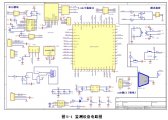空巢老人家居安全监测设备开发(物联网)

空巢老人家居安全监测设备开发(物联网)(论文14000字)
摘要:针对当前空巢老人家居安全问题,本毕业设计使用物联网技术开发了空巢老人家居安全监测设备。所开发的设备包括STM32核心处理模块、烟雾传感器模块、DHT11温度传感器模块、红外传感器模块及LED显示屏模块等。所制作的空巢老人家居安全监测设备,可通过WiFi无线通信,将收集到的数据发送到云服务中心。同时,用户可以通过手机APP对设备进行管理,解决空巢老人家居安全问题。所开发的空巢老人家居安全监测设备具有低功耗、体积小部署方便、安全性高及稳定性高的特点。同时,所开发的软硬件系统可以实现监测家中烟雾浓度、人体红外数据、温湿度,远程提醒、沟通等功能,可保障空巢老人可以获得安全舒适的生活,具有较好的经济及社会效益。
关键词:空巢老人;家居安全;物联网技术;PCB设计;STM32
Development of Home Safety Monitoring Equipment for Empty Nest Elderly.
Abstract:In view of the current home safety problems of empty nesters, this graduation project uses the Internet of Things technology to develop the home safety monitoring equipment for empty nesters. The developed equipment includes STM32 core processing module, smoke sensor module, DHT11 temperature sensor module, infrared sensor module and LED display module. The home security monitoring device for empty nesters can send the collected data to the cloud service center through WiFi wireless communication. At the same time, users can manage the equipment through mobile APP to solve the problem of home security for empty nesters. The developed home safety monitoring equipment for empty nesters has the characteristics of low power consumption, small size, convenient deployment, high security and high stability. At the same time, the developed software and hardware system can monitor smoke concentration, infrared data of human body, temperature and humidity, remote reminder, communication and other functions. It can ensure that empty nesters can get a safe and comfortable life, with better economic and social benefits.
[资料来源:http://Doc163.com]
Key words:empty nester; home security; Internet of things technology; PCB design; STM32
[资料来源:Doc163.com]


目 录
第一章 绪论 1
1.1 本课题研究背景及意义 1
1.2 与本课题相关的国内外研究状况 1
1.3 研究内容及系统介绍 2
第二章 相关技术简介 3
2.1 系统开发工具及运行环境 3
2.2 相关开发技术 3
2.2.1 Keil uVision设备软件开发技术 3
2.2.2 JavaScript开发技术 4
2.2.3 CSS开发技术 4
2.2.4 MySQL数据库 4
2.2.5腾讯云服务器 4
第三章 系统需求分析 5
3.1 设备功能需求分析 5
3.2 系统功能需求分析 5
3.2.1 安卓客户端功能需求 5
3.2.2 Web后台管理功能需求 6
3.3 性能需求分析 6
第四章 系统设计 7
4.1 系统网络拓扑结构图 7
4.2 管理系统功能模块设计 7
4.3 管理系统核心功能流程设计 8
4.4 数据库设计 10
第五章 物联网设备设计与制作 14
5.1 原理图设计 14
5.1.1 MT7681通信模块驱动电路 14
5.1.2LCD液晶显示屏驱动电路 15
5.1.3 DHT11驱动电路 16
5.1.4 MQ2传感器电路 16
5.1.5 人体红外传感器 17
5.1.6 继电器驱动电路 18
5.1.8 稳压电路5.1.7 串口及USB-232 18
5.1.8 稳压电路 19
5.1.9晶振电路 19
5.1.8模式选择电路 20
5.2 制作设备的电子元器件 20
5.2.1 stm32f103ret6核心控制模块 20
5.2.2 MT7681(WiFi)模块 21
5.2.3 Risym 0.96寸OLED显示屏 21
5.2.4 MQ-2液化气 天然气 城市煤气传感器模块 22
5.2.5 人体红外感应模块 22
5.1.6 DHT11温湿度传感器 23
5.3 元器件封装设计 23
5.3.1 stm32f103ret6core模块封装 23
5.3.2 晶振模块封装 24
5.3.3 电源开关模块封装 24
5.3.4 AMS1117芯片封装 24
5.3.5 稳压二极管封装 25
5.3.6 MT7681封装 25
5.3.7 DHT11封装 26
5.3.8 LCD液晶显示屏封装 26
5.4 设备硬件程序设计 26
5.4.1 设备硬件程序编写 26 [资料来源:http://doc163.com]
5.5 元器件布局电路布线 31
5.6 PCB打样及成品组装 33
第六章 设备管理系统功能实现 33
6.1 安卓App实现 33
6.1.1 帐号登陆与注册 34
6.1.2 首页查看与设备查看 34
6.1.3 设备绑定 35
6.1.4 历史数据查看与预警值设置 36
6.1.5用户反馈与个人中心 36
6.2 Web端后台管理实现 37
6.2.1 管理后台登陆实现 37
6.2.2 超级管理员的主界面 38
6.2.3 超级管理员的通知设置 38
6.2.4 超级管理员的普通管理员管理模块 39
6.2.5 普通管理员主界面 40
6.2.6 管理员的系统公告设置 40
6.2.7 用户的安全日志查看 41
6.2.8 普通管理员的个人信息查看 41
6.2.9 用户个人信息修改 42
6.2.10 用户反馈 42
[资料来源:www.doc163.com]
6.2.11 产品操作 43
第七章 系统测试 44
7.1 单元测试与集成测试 44
第八章 结论 45
参考文献 46
致 谢 48
[来源:http://www.doc163.com]
